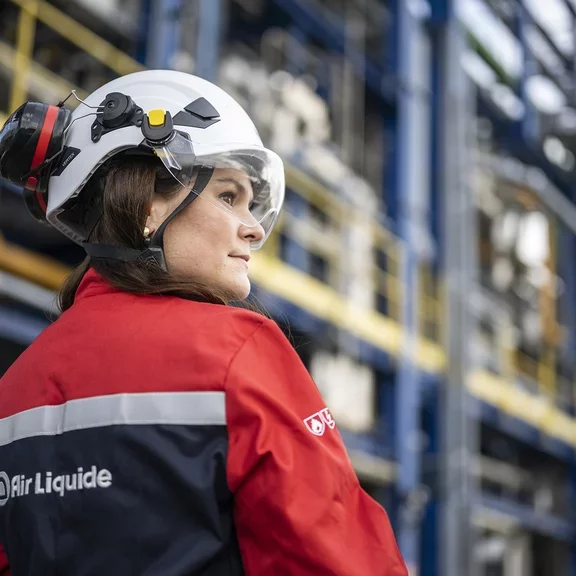Investing in the energy transition, investing in the future
Published on March 26, 2024
5 minutes

The Group’s consistent financial performance provides the resources it needs to finance large-scale projects and realize its long-term vision. This vision includes the transition to low-carbon industry, both in terms of its own activities and in terms of support for its industrial customers.
Industry, particularly heavy industry, is a major emitter of carbon dioxide, accounting for around 20% of global CO2 emissions. To achieve carbon neutrality, there must therefore be a drastic and rapid reduction of these emissions. To contribute to this vital decarbonization, Air Liquide allocates nearly half of its investment decisions to key projects that will contribute to the fight against global warming. And because it strongly believes in the power of collaboration, Air Liquide is establishing various partnerships in a wide range of sectors, particularly those with the highest emissions and that are hardest to abate. Working alongside its customers, the Group is investing significant resources to accelerate the transition to a low-carbon industry.
As part of its ADVANCE strategic plan, Air Liquide is committed to supporting its industrial customers in decarbonizing their activities through a portfolio of technological solutions. 2023 saw a significant increase in this dynamic with strategic investments and key partnerships. For instance, the Group signed an agreement to decarbonize the Belgian plant of the Swiss company Holcim, one of the world’s leading cement manufacturers, using its proprietary technology, CryocapTM. Developed by Air Liquide, the CryocapTM process captures CO2 by liquefying it through cryogenics. This technology will enable the cement plant to reduce its CO2 emissions by 1.1 million tonnes every year.
Using the same technology, Air Liquide will help transform one of EQIOM’s cement plants in France into Europe’s first carbon-neutral cement plant by 2028. The project, known as K6, has received funding of 150 million euros from the European Innovation Fund and aims to capture nearly 8 million tonnes of CO2 during the first 10 years of operation.
This CryocapTM technology was used for the first time in 2015 in Port-Jérôme in Normandy, on the Group’s largest hydrogen production site in France.
19
major projects that will support the energy transition are being developed by the Group in Europe
Close to this site and with the support of the French government, Air Liquide is now building a world-scale PEM (proton exchange membrane) electrolyzer, with a capacity of 200 megawatts, as part of the Normand’Hy project. The objective is to produce up to 28,000 tonnes of decarbonized hydrogen per year, beginning in 2026. This unique facility will be equipped with the latest-generation PEM electrolysis modules, produced by the new gigafactory operated by Air Liquide and Siemens Energy in Berlin, Germany.
Half of the hydrogen produced by this electrolyzer will be used by the TotalEnergies refinery located in the same industrial basin. At the same time, TotalEnergies will provide renewable electricity to cover half the energy needs of Air Liquide’s Normand’Hy. This is an ambitious project: in addition to avoiding annual emissions of 250,000 tonnes of CO2, this will be the first low-carbon hydrogen supply chain in Europe. Many other projects like this are also being developed by the Group, particularly in Europe. This extensive portfolio makes Air Liquide a pioneer and a leader in the energy transition.
When it comes to large-scale decarbonized hydrogen, Air Liquide has already demonstrated its industrial capabilities in operating electrolyzers for the last 3 years in Bécancour, Canada. With a capacity of 20 megawatts to produce 8 tonnes of hydrogen every day, this is enough to power 2,000 cars, 16,000 forklift trucks, 275 buses or 230 large trucks!
This electrolyzer is at the heart of a new low-carbon gas production platform that is being developed by Air Liquide in Quebec to produce renewable hydrogen, oxygen, nitrogen and argon. In addition to the existing electrolyzer, the investment project of more than 140 million euros will include a new renewable oxygen and nitrogen production unit and significant liquid storage capacity, connected by a pipeline network to better serve local customers. This new infrastructure is part of a wider process to decarbonize Bécancour’s industrial zone and port, making it a unique place to produce renewable industrial gases and thereby develop offerings with high added value for our customers who are committed to the energy transition.
"We are proactively stepping up our efforts to develop a more sustainable industry. Our technologies, particularly our proprietary carbon-capture solution CryocapTM and our electrolyzers for low-carbon hydrogen production, as well as our many collaborations and partnerships with customers position us as a leading player when it comes to the major challenge of the energy transition."
Chris Clark
Vice President of Large Industries at Air Liquide
In addition to these investments in projects for carbon capture and hydrogen production through electrolysis, the Group is pursuing several other strategies to accelerate the energy transition. For instance, it is working with KBR, the world leader in ammonia technology, to provide solutions to produce low-carbon ammonia by using the autothermal reforming (ATR) process developed by Air Liquide. This technology, in which the Group is a world leader, is one of the most promising solutions for the large-scale production of low-carbon hydrogen; it is then combined with nitrogen to produce low-carbon ammonia. The solutions provided in collaboration with KBR will also contribute to the development of a global low-carbon hydrogen market because hydrogen, when transformed into ammonia, can easily be transported over long distances.
Lastly, the Group is supporting sustainable mobility by contributing to the development of hydrogen ecosystems with major players including TotalEnergies, Lotte, Eneos and Trillium Energy Solutions. The aim is to accelerate the adoption of hydrogen, particularly for heavy mobility.
All these strategic investments underline Air Liquide’s proactive approach to the creation of a low-carbon society.



